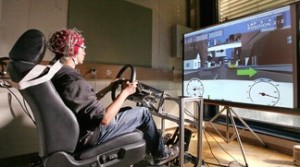Swiss Nano-Tera program researchers have developed an implantable lab-on-a-chip which can test blood and convey the results to your doctor (once they take the device out of the laboratory) according to a Mar. 19, 2013 news release on EurekAlert,
Humans are veritable chemical factories – we manufacture thousands of substances and transport them, via our blood, throughout our bodies. Some of these substances can be used as indicators of our health status. A team of EPFL (École Polytechnique Fédérale de Lausanne) scientists has developed a tiny device that can analyze the concentration of these substances in the blood. Implanted just beneath the skin, it can detect up to five proteins and organic acids simultaneously, and then transmit the results directly to a doctor’s computer. This method will allow a much more personalized level of care than traditional blood tests can provide. Health care providers will be better able to monitor patients, particularly those with chronic illness or those undergoing chemotherapy. The prototype, still in the experimental stages, has demonstrated that it can reliably detect several commonly traced substances. The research results will be published and presented March 20, 2013 in Europe’s largest electronics conference, DATE 13.
Design, Automation, and Test in Europe (DATE) 2013 can be found here. For those of us who won’t be at the DATE 13 conference, this EPFL video highlights some of the research being presented there,
The EPFL Mar. 20, 2013 news release provides more information about the technology and potential applications,
The device was developed by a team led by EPFL scientists Giovanni de Micheli and Sandro Carrara. The implant, a real gem of concentrated technology, is only a few cubic millimeters in volume but includes five sensors, a radio transmitter and a power delivery system. Outside the body, a battery patch provides 1/10 watt of power, through the patient’s skin – thus there’s no need to operate every time the battery needs changing.
Information is routed through a series of stages, from the patient’s body to the doctor’s computer screen. The implant emits radio waves over a safe frequency. The patch collects the data and transmits them via Bluetooth to a mobile phone, which then sends them to the doctor over the cellular network.
…
Great care was taken in developing the sensors. To capture the targeted substance in the body – such as lactate, glucose, or ATP – each sensor’s surface is covered with an enzyme. “Potentially, we could detect just about anything,” explains De Micheli. “But the enzymes have a limited lifespan, and we have to design them to last as long as possible.” The enzymes currently being tested are good for about a month and a half; that’s already long enough for many applications. “In addition, it’s very easy to remove and replace the implant, since it’s so small.”
The electronics were a considerable challenge as well. “It was not easy to get a system like this to work on just a tenth of a watt,” de Micheli explains. The researchers also struggled to design the minuscule electrical coil that receives the power from the patch.
…
The implant could be particularly useful in chemotherapy applications. Currently, oncologists use occasional blood tests to evaluate their patients’ tolerance to a particular treatment dosage. In these conditions, it is very difficult to administer the optimal dose. …
In patients with chronic illness, the implants could send alerts even before symptoms emerge, and anticipate the need for medication. “In a general sense, our system has enormous potential in cases where the evolution of a pathology needs to be monitored or the tolerance to a treatment tested.”
The prototype has already been tested in the laboratory for five different substances, and proved as reliable as traditional analysis methods. The project brought together eletronics experts, computer scientists, doctors and biologists from EPFL, the Istituto di Ricerca di Bellinzona, EMPA (Swiss Federal Laboratories for Materials Science and Technology) and ETHZ (Eidgenössische Technische Hochschule Zürich). It is part of the Swiss Nano-Tera program, whose goal is to encourage interdisciplinary research in the environmental and medical fields. Researchers hope the system will be commercially available within 4 years. [emphases mine]
“Making this technology commercially available within four years” seems rather optimistic since the news release mentions laboratory testing only. Optimistic that is, unless the researchers are already running human clinical trials not mentioned in the news release.
One last thought, objects implanted into the body tend to break down over time as per hip and knee replacements. I wonder if this lab-on-a-chip could be subject to some of the same drawbacks.
